| Tampa International Airport People Movers | ||||||||||||||||||||||||||||||||||||||||||||||||||||||||||||||||||||||||||||||||||||||||||||||||||||||||||||||||||||||||||||||||||||||||||||||||||||||||||||||||||||||||
|---|---|---|---|---|---|---|---|---|---|---|---|---|---|---|---|---|---|---|---|---|---|---|---|---|---|---|---|---|---|---|---|---|---|---|---|---|---|---|---|---|---|---|---|---|---|---|---|---|---|---|---|---|---|---|---|---|---|---|---|---|---|---|---|---|---|---|---|---|---|---|---|---|---|---|---|---|---|---|---|---|---|---|---|---|---|---|---|---|---|---|---|---|---|---|---|---|---|---|---|---|---|---|---|---|---|---|---|---|---|---|---|---|---|---|---|---|---|---|---|---|---|---|---|---|---|---|---|---|---|---|---|---|---|---|---|---|---|---|---|---|---|---|---|---|---|---|---|---|---|---|---|---|---|---|---|---|---|---|---|---|---|---|---|---|---|---|---|---|
_and_Airside_A_(right)_People_Movers.jpg.webp) SkyConnect (left) and Airside A (right) people movers | ||||||||||||||||||||||||||||||||||||||||||||||||||||||||||||||||||||||||||||||||||||||||||||||||||||||||||||||||||||||||||||||||||||||||||||||||||||||||||||||||||||||||
| Overview | ||||||||||||||||||||||||||||||||||||||||||||||||||||||||||||||||||||||||||||||||||||||||||||||||||||||||||||||||||||||||||||||||||||||||||||||||||||||||||||||||||||||||
| Locale | Tampa International Airport | |||||||||||||||||||||||||||||||||||||||||||||||||||||||||||||||||||||||||||||||||||||||||||||||||||||||||||||||||||||||||||||||||||||||||||||||||||||||||||||||||||||||
| Stations | 11 | |||||||||||||||||||||||||||||||||||||||||||||||||||||||||||||||||||||||||||||||||||||||||||||||||||||||||||||||||||||||||||||||||||||||||||||||||||||||||||||||||||||||
| Service | ||||||||||||||||||||||||||||||||||||||||||||||||||||||||||||||||||||||||||||||||||||||||||||||||||||||||||||||||||||||||||||||||||||||||||||||||||||||||||||||||||||||||
| Type | Automated guideway transit | |||||||||||||||||||||||||||||||||||||||||||||||||||||||||||||||||||||||||||||||||||||||||||||||||||||||||||||||||||||||||||||||||||||||||||||||||||||||||||||||||||||||
| Services | 5 | |||||||||||||||||||||||||||||||||||||||||||||||||||||||||||||||||||||||||||||||||||||||||||||||||||||||||||||||||||||||||||||||||||||||||||||||||||||||||||||||||||||||
| Rolling stock |
| |||||||||||||||||||||||||||||||||||||||||||||||||||||||||||||||||||||||||||||||||||||||||||||||||||||||||||||||||||||||||||||||||||||||||||||||||||||||||||||||||||||||
| History | ||||||||||||||||||||||||||||||||||||||||||||||||||||||||||||||||||||||||||||||||||||||||||||||||||||||||||||||||||||||||||||||||||||||||||||||||||||||||||||||||||||||||
| Opened | 1971 (airside systems) 1991 (monorail) 2018 (SkyConnect) | |||||||||||||||||||||||||||||||||||||||||||||||||||||||||||||||||||||||||||||||||||||||||||||||||||||||||||||||||||||||||||||||||||||||||||||||||||||||||||||||||||||||
| Closed | 2020 (monorail)[2] | |||||||||||||||||||||||||||||||||||||||||||||||||||||||||||||||||||||||||||||||||||||||||||||||||||||||||||||||||||||||||||||||||||||||||||||||||||||||||||||||||||||||
| ||||||||||||||||||||||||||||||||||||||||||||||||||||||||||||||||||||||||||||||||||||||||||||||||||||||||||||||||||||||||||||||||||||||||||||||||||||||||||||||||||||||||
The Tampa International Airport People Movers are a set of automated people mover systems operating within Tampa International Airport. The primary set of people movers are automated guideway transit (AGT) systems that connect the airport's main terminal to four satellite airside concourses. Opened in 1971, the landside/airside shuttles were the first people movers used to transport passengers within an airport terminal and it is today Bombardier Transportation's longest running people mover system. A fifth people mover line known as SkyConnect, which began operating in 2018, connects the main terminal with the airport's economy parking garage and rental car center. In addition, a monorail once connected the main terminal and the long-term parking garage from 1991 until its closure in 2020.
Landside/Airside shuttles

The four currently operating airside automated guideway transit (AGT) people mover systems operate as shuttles connecting the main terminal on Level 3 to airside concourses A, C, E, and F. Each airside has its own line, which consists of two guideways with an emergency walkway between them (which can be used to evacuate a shuttle or be used for people to walk should the shuttles fail). On each line, the two guideways each carry a two-car train (one red train and one blue train) consisting of Bombardier Innovia APM 100 vehicles. The shuttles simply run back and forth between the main terminal and the airsides buildings. Passengers board on an island platform between the two guideways and disembark on side platforms at both ends. All main terminal platforms contain platform screen doors, while the airside platforms contain steel doors. The vehicles are serviced at the airside stations where maintenance bays exist beneath the guideways.[3]
Tampa Mayor Jane Castor delivers pre-recorded greetings to travelers on the shuttles as they run between the stations.[4] Tampa's previous mayor Bob Buckhorn also provided these greetings during his tenure as Mayor of Tampa.[5]
History
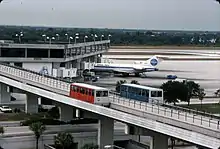
When the terminal opened in 1971, the landside/airside shuttles were the first automated people mover systems to operate in an airport. The shuttles were originally built by Westinghouse Electric Corporation (who was also contracted to install the terminal's original elevators and escalators). Upon opening, the airport included lines to Airsides B, C, D, and E using eight first-generation Westinghouse C-100 vehicles (one vehicle on each guideway).[6] [7] Local WFLA radio personality Jack Harris provided the original voice for the audio announcements for the shuttles (and other announcements throughout the airport).[8]
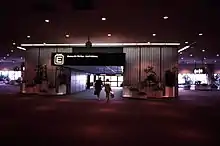
Tampa International Airport's landside/airside design was the first of its type in the world, and the use of people movers to shuttle people between the landside terminal and airside concourses was a key part of keeping walking distances short. The airport's layout was so well received that it was largely replicated at Orlando International Airport (complete with its own landside/airside shuttles built by Westinghouse) in 1981.[9]
Airside F was added to the airport in 1987 along with an additional shuttle line. Airside F's shuttles included new second-generation C-100 vehicles, and it would be the first airside system to include two-car trains.[10] Airside F's shuttle station was built on the second level of the airside building (the same level as the passenger boarding jetways) unlike the original airsides, which had their shuttle stations on the third level (the same as the landside terminal). This was due to the improved technology of the second-generation C-100 vehicles, which could better handle inclines than the original vehicles and it eliminated the need for passengers to descend a level to access aircraft.[9] Every subsequent airside would have its shuttle station on the second level.

Airside B closed permanently in 1991. In lieu of reopening Airside B, Airside A was built in 1995. Airside A's shuttle system has operated with CX-100 vehicles (known today as the Bombardier Innovia APM 100) since its opening and it operates with two-car trains. After its closure, Airside B's shuttles remained dormant on the guideway until the airside was demolished in 2003.[11] Despite the demolition, part of the shuttle guideway to the former Airside B still remains abandoned at the airport today.[10]
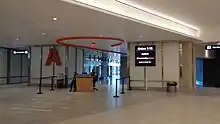
In 1996, the original Airside C and Airside D were renovated. As part of the renovation, the original vehicles on their people movers were replaced with CX-100 vehicles along with other upgrades to the systems. Upon completion of the renovations, the original Airside E closed which led to the retirement of the last of the airport's original C-100 vehicles.[10]
Airside E was rebuilt in 2002, and its new shuttles included CX-100 vehicles running in two-car trains. Airside C was then demolished and rebuilt. During the rebuild, the airport saved $4 million by reusing 420 feet of the original Airside C's shuttle guideway and the CX-100 vehicles, which were installed in 1996. The vehicles were refurbished and resumed service when the rebuilt Airside C opened in April of 2005.[12]
One month after Airside C reopened, Airside D closed permanently. Airside D's CX-100 vehicles, which were also installed in 1996, were refurbished and were relocated to Airside C, where they were used to expand the existing shuttles to two-car trains. Airside D was demolished in 2007, though much of the shuttle infrastructure was left in place until 2019.[12]
Airside F's second-generation C-100 vehicles were replaced with CX-100 vehicles by Bombardier (who has since acquired the remains of Westinghouse's transportation department) in 2008.[12]
In 2018, work was complete to remodel the main terminal. As part of the renovation, the shuttle stations were rebuilt and moved outward to give the center of the building more space on Level 3. The Airside D shuttle station, which had been simply roped off since its closure, was also removed at the same time and was replaced with a food court.[13] The rest of the Airside D guideway was demolished in 2019.[14]
Future
Tampa International Airport is preparing to built a replacement Airside D, which includes a new Airside D shuttle system. Construction is underway on a new shuttle station in the main terminal and the new Airside is set to be complete in 2028.[15]
The airport is also in the process of replacing the shuttle vehicles on Airsides A and C (which have been in service since the mid 1990s). Alstom, which acquired Bombardier's transportation division in 2021, will supply the new Innovia APM 300R trains which will debut in 2025. The project will also rehabilitate the guideways as well. The Innovia APM 300R vehicles will also be used on the new Airside D shuttle system. The airport also plans to replace Airside E and Airside F's shuttles with new Innovia APM 300R by the end of the decade.[16]
SkyConnect
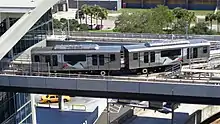

An additional people mover line named SkyConnect connects the main terminal with the rental car center and the economy parking garage. SkyConnect has three stations: one on Level 4 of the main terminal (right above the former station for the shuttle line to Airside B), the economy parking garage, and the rental car center (which includes access to low-cost rentals and a remote curbside). The guideway primarily runs along the airport's entrance road, George J. Bean Parkway, and passes underneath Taxiway J to connect with rental car and parking facilities. SkyConnect opened in 2018 and was built in conjunction with those facilities.[17]
Unlike the landside/airside shuttles, SkyConnect uses Mitsubishi Crystal Mover vehicles. The trains run between the three stations in a pinched-loop configuration.[18]
Long-Term Parking Monorail (defunct)
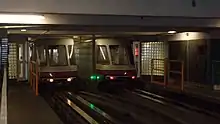

An automated monorail system also once connected the main terminal on Level 5 to the long-term parking garage,[19] stopping at each elevator bank in both buildings. It was installed in 1991 when the long-term parking garage was built.[10] It used six Bombardier UM III vehicles, which are also used on the Jacksonville Skyway.[1]
The monorail was located on level 7 of the long-term parking garage, where it ran in a loop between the four elevator banks with stations at each bank. Once it completed the loop, it crossed a bridge onto level 5 of the short-term parking garage. In the short-term garage, it ran in a straight path between the four elevator banks, which passengers could use to access the terminal. The monorail made three stops in the short-term garage providing access to the four elevator banks before returning to the long-term garage and repeating the loop. Bombardier Transportation maintained the system by contract and it was monitored from the airport's communications center. The monorail ran 24 hours a day except for a once-a-week maintenance shut-down in the overnight hours. Thales Rail Signalling Solutions won a contract in 2008 to completely upgrade the computer control system.[20]
Following the monorail's closure in early 2020, the airport opted not to invest in a replacement system due to high costs. Instead, a series of moving walkways are being constructed on Level 4 of the long term garage to allow passengers to access the main terminal more quickly via the outdoor connecting bridges.[21]
See also
References
- 1 2 "Monorails of North America". The Monorail Society. Retrieved September 24, 2017.
- ↑ "Monorail Decommissioning and Moving Walkway – Manhattan" (PDF). June 4, 2020.
- ↑ "Tampa, Florida Airport People Movers". NYCSubway.org. Retrieved 16 February 2022.
- ↑ Varian, Bill (6 June 2019). "'Hi, this is Mayor Jane Castor'". Tampa Bay Times. Retrieved 11 December 2021.
- ↑ Saunders, Jim (30 May 2012). "Scott wants to be beamed up, into Tampa airport shuttles". Palm Beach Post. Retrieved 11 December 2021.
- ↑ "Landside/Airside Terminal 1961–1979". Juan's Tampa International Airport Page. Retrieved 26 October 2021.
- ↑ Groot, Marnix. "Great Terminals of the Jet Age: Tampa at 50". AirportHistory.org. Retrieved 4 December 2021.
- ↑ Calise, Gabrielle (15 April 2021). "'New' Tampa International Airport opened 50 years ago. Here's what it was like". Tampa Bay Times. Retrieved 12 May 2022.
- 1 2 "Orlando International Airport: The story of MCO's past and present terminal building". Golldiecat's Airport-Page. Retrieved 16 February 2022.
- 1 2 3 4 "Landside/Airside Terminal 1980–1999". Juan's Tampa International Airport Page. Retrieved 26 October 2021.
- ↑ "Tampa, Florida Airport People Movers: Showing Image 13230". NYCSubway.org. Retrieved 16 February 2022.
- 1 2 3 "Landside/Airside Terminal 2000–Present". Juan's Tampa International Airport Page. Retrieved 26 October 2021.
- ↑ "Tampa International Airport (TPA) Main Terminal and Airport Concession Redevelopment Program". Skanska. Retrieved 4 December 2021.
- ↑ "TPA begins a busy year of construction on Master Plan Phase 2". Tampa International Airport. Retrieved 4 December 2021.
- ↑ "TPA's Red Side expansion continues as new structures begin to take shape". Tampa International Airport. Retrieved 4 January 2024.
- ↑ "New shuttles coming to two Airsides at TPA". Tampa International Airport. Retrieved 4 January 2024.
- ↑ Valentine, Danny (June 13, 2017). "Tampa International Airport's new $417M people mover is en route from Japan". Tampa Bay Business Journal. American City Business Journals. Retrieved October 20, 2018.
- ↑ Elliott, Dennis M.; Norton, Jack (1999). "An Introduction To Airport Apm Systems". Journal of Advanced Transportation. 33: 35–50. doi:10.1002/atr.5670330105. Retrieved 23 November 2021.
- ↑ "Parking". Tampa International Airport. Retrieved July 16, 2017.
- ↑ "SelTrac® CBTC, Communications-Based Train Control For Urban Rail – Thales". Thalesgroup.com. Archived from the original on February 24, 2012. Retrieved July 5, 2013.
- ↑ Tampa Airport (September 20, 2021). "TPA gears up for new moving walkways". Retrieved September 27, 2021.